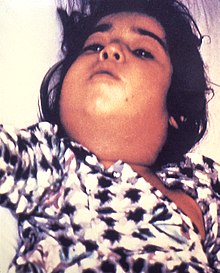| Diphtheria | |
|---|---|
 | |
| Diphtheria can cause a swollen neck, sometimes referred to as a bull neck.[1] | |
| Specialty | Infectious disease |
| Symptoms | Sore throat, fever, barky cough[2] |
| Usual onset | 2–5 days post-exposure[1] |
| Causes | Corynebacterium diphtheriae (spread by direct contact and through the air)[1] |
| Diagnostic method | Throat appearance, culture[2] |
| Prevention | Diphtheria vaccine[1] |
| Treatment | Antibiotics, tracheostomy[1] |
| Frequency | 4,500 (reported 2015)[3] |
| Deaths | 2,100 (2015)[4] |
Diphtheria is an infection caused by the bacterium Corynebacterium diphtheriae.[1] Signs and symptoms may vary from mild to severe.[2] They usually start two to five days after exposure.[1] Symptoms often come on fairly gradually, beginning with a sore throat and fever.[2] In severe cases, a grey or white patch develops in the throat.[1][2] This can block the airway and create a barking cough as in croup.[2] The neck may swell in part due to enlarged lymph nodes.[1] A form of diphtheria which involves the skin, eyes or genitals also exists.[1][2] Complications may include myocarditis, inflammation of nerves, kidney problems, and bleeding problems due to low levels of platelets.[1] Myocarditis may result in an abnormal heart rate and inflammation of the nerves may result in paralysis.[1]
Diphtheria is usually spread between people by direct contact or through the air.[1][5] It may also be spread by contaminated objects.[1] Some people carry the bacterium without having symptoms, but can still spread the disease to others.[1] The three main types of C. diphtheriae cause different severities of disease.[1] The symptoms are due to a toxin produced by the bacterium.[2] Diagnosis can often be made based on the appearance of the throat with confirmation by microbiological culture.[2] Previous infection may not protect against future infection.[2]
A diphtheria vaccine is effective for prevention and available in a number of formulations.[1] Three or four doses, given along with tetanus vaccine and pertussis vaccine, are recommended during childhood.[1] Further doses of diphtheria-tetanus vaccine are recommended every ten years.[1] Protection can be verified by measuring the antitoxin level in the blood.[1] Diphtheria can be prevented in those exposed as well as treated with the antibiotics erythromycin or benzylpenicillin.[1] A tracheotomy is sometimes needed to open the airway in severe cases.[2]
In 2015, 4,500 cases were officially reported worldwide, down from nearly 100,000 in 1980.[3] About a million cases a year are believed to have occurred before the 1980s.[2] Diphtheria currently occurs most often in sub-Saharan Africa, India, and Indonesia.[2][6] In 2015, it resulted in 2,100 deaths, down from 8,000 deaths in 1990.[4][7] In areas where it is still common, children are most affected.[2] It is rare in the developed world due to widespread vaccination but can re-emerge if vaccination rates decrease.[2][8] In the United States, 57 cases were reported between 1980 and 2004.[1] Death occurs in 5% to 10% of those diagnosed.[1] The disease was first described in the 5th century BC by Hippocrates.[1] The bacterium was identified in 1882 by Edwin Klebs.[1]
References
edit- ^ a b c d e f g h i j k l m n o p q r s t u v w x y Atkinson, William (May 2012). Diphtheria Epidemiology and Prevention of Vaccine-Preventable Diseases (12 ed.). Public Health Foundation. pp. 215–230. ISBN 9780983263135. Archived from the original on 15 September 2016.
- ^ a b c d e f g h i j k l m n o "Diphtheria vaccine" (PDF). Wkly Epidemiol Rec. 81 (3): 24–32. 20 January 2006. PMID 16671240. Archived (PDF) from the original on 6 June 2015.
- ^ a b "Diphtheria". who.int. 3 September 2014. Archived from the original on 2 April 2015. Retrieved 27 March 2015.
- ^ a b GBD 2015 Mortality and Causes of Death, Collaborators. (8 October 2016). "Global, regional, and national life expectancy, all-cause mortality, and cause-specific mortality for 249 causes of death, 1980–2015: a systematic analysis for the Global Burden of Disease Study 2015". Lancet. 388 (10053): 1459–1544. doi:10.1016/s0140-6736(16)31012-1. PMC 5388903. PMID 27733281.
{{cite journal}}:|first1=has generic name (help)CS1 maint: numeric names: authors list (link) - ^ Kowalski, Wladyslaw (2012). Hospital airborne infection control. Boca Raton, Florida: CRC Press. p. 54. ISBN 9781439821961. Archived from the original on 21 December 2016.
- ^ Mandell, Douglas, and Bennett's Principles and Practice of Infectious Diseases (8 ed.). Elsevier Health Sciences. 2014. p. 2372. ISBN 9780323263733. Archived from the original on 21 December 2016.
- ^ GBD 2013 Mortality and Causes of Death, Collaborators (17 December 2014). "Global, regional, and national age-sex specific all-cause and cause-specific mortality for 240 causes of death, 1990–2013: a systematic analysis for the Global Burden of Disease Study 2013". Lancet. 385 (9963): 117–71. doi:10.1016/S0140-6736(14)61682-2. PMC 4340604. PMID 25530442.
{{cite journal}}:|first1=has generic name (help)CS1 maint: numeric names: authors list (link) - ^ Al, A. E. Paniz-Mondolfi et (2019). "Resurgence of Vaccine-Preventable Diseases in Venezuela as a Regional Public Health Threat in the Americas – Volume 25, Number 4 – April 2019 – Emerging Infectious Diseases journal – CDC". Emerging Infectious Diseases. 25 (4): 625–632. doi:10.3201/eid2504.181305. PMC 6433037. PMID 30698523.